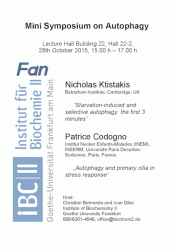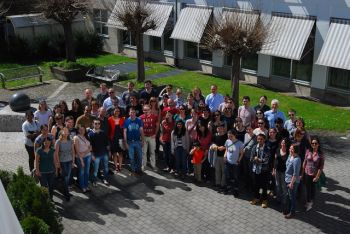News from the Institute

The Frankfurt Autophagy Network (FAN) and the Institute of Biochemistry II (IBCII) recently hosted two scientists studying the process of autophagy with state-of-the-art microscopy techniques.
Whereas Dr. Nicholas Ktistakis (Babraham Institute, Cambridge, UK) employs high-resolution microscopy to investigate the early processes at the onset of autophagy, Dr. Patrice Codogno (Institute Necker Enfants-Malades, INSERM, Paris, France) is interested in the interplay of primary cilia with autophagy and on the precise cellular sites where the autophagic machinery assembles.
... (read more)
From September 18th to September 22nd 2015 the EMBO conference „Ubiquitin and ubiquitin-like modifiers“ was taking place in Cavtat, Croatia. More than 350 participants enjoyed five days of excellent scientific talks, networking and poster presentations in the stimulating atmosphere of the Adriatic Coast.
... (read more)
The beautiful landscape of Heilbronner Land was the destination of choice for this years’s retreat of the Institute of Biochemistry II which took place from April 15th to April 17th 2015.
3 days full of scientific discussions and exchange as well as many opportunities to socialize during common events promoted the interactive spirit amongst the institute members and raised new interactions and collaborations.
... (read more)
The European Academy (Academia Europaea) announces the list of 248 scientists who were elected to the academy in 2015. Amongst them is Prof. Ivan Dikic, director of the Institute of Biochemistry 2 at the Medical School Goethe University and founding director of the Buchmann Institute for Molecular Sciences (BMLS).
The Academia Europaea was founded in 1988 as a European Academy of humanities, social, physical and life sciences as well as mathematics, engineering and medicine.
... (read more)
Prof. Ivan Dikic has been appointed as a senior editor of the scientific journal eLife in the area of molecular signalling and quality control pathways. Since 2013, he has been serving on the board of editors of this unique journal, which is driven by a non-profit, researcher-led initiative and is supported by the Howard Hughes Medical Institute, the Wellcome Trust and the Max Planck Society.
... (read more)